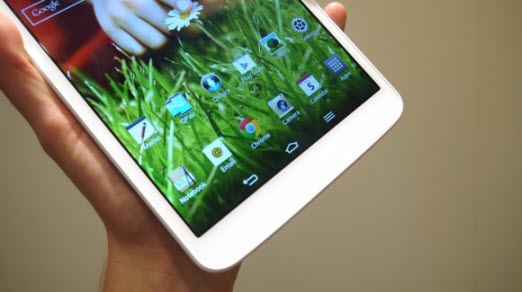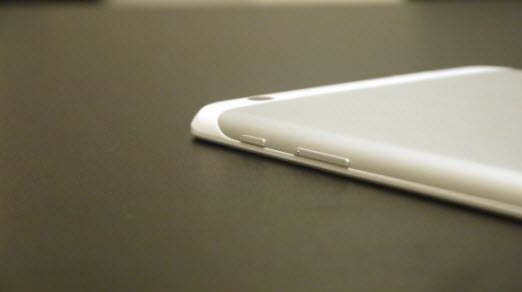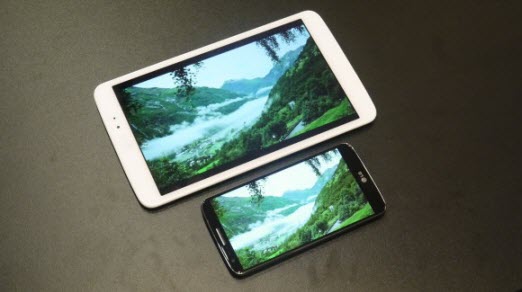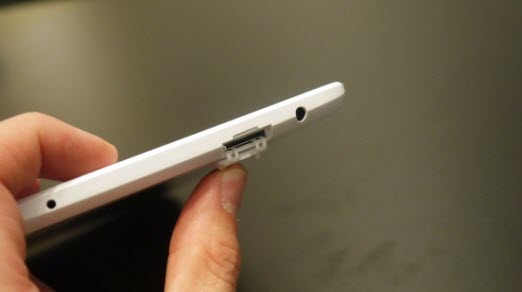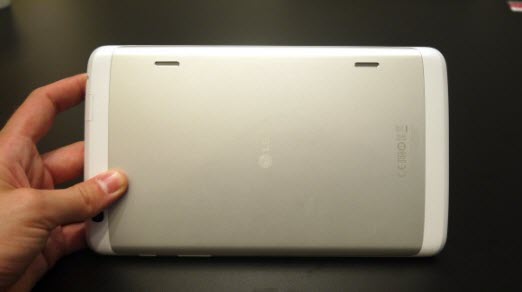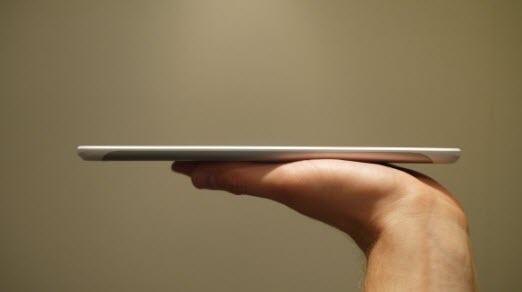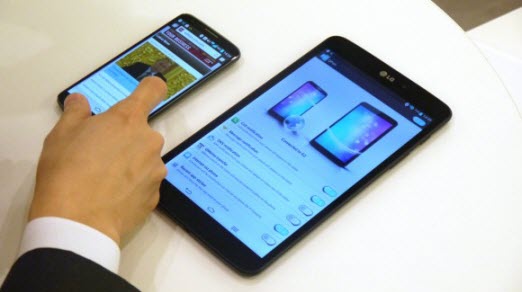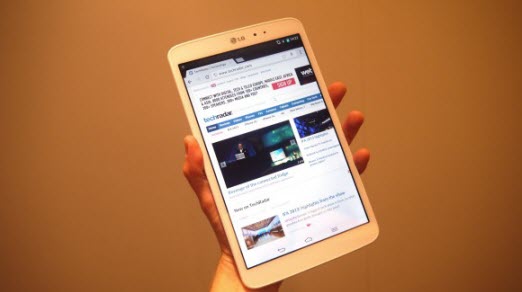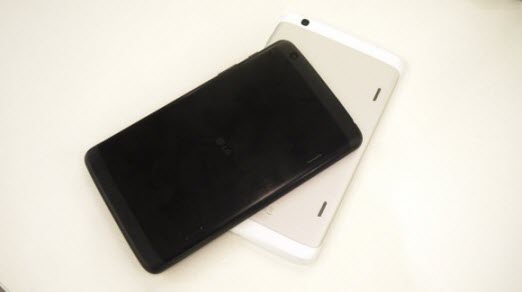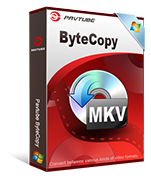LG has sprung a surprise: a slick and well-designed tablet that impresses without the headline specs.
When you first pick up the LG Pad 8.3, you’d be forgiven for thinking it was from another brand. That’s no disrespect to LG, but more a statement showing that it’s a company that’s changing its mindset in the phones and tablets market.
While the smartphone arena is dominated by the G2 for the company, with its rear volume keys, the G Pad 8.3 is a slim and mostly metal device, something LG tells us is inspired by car and aeroplane monocoques.
The metal is surrounded by harder plastic, but LG also said that the decision to use metal for a large part of the rear of the device contributed to actually lower weight, rather than increasing it at the expense of using a more premium material.
The effect is one that’s closer to the HTC One than the iPhone 5, by which we mean that the weight, of 338g, feels just right, with a decent balance.
LG explained that the decision to use an 8.3-inch screen was nothing to do with the desire to one-up any rivals in the same space (a not-so-subtle nod to the Galaxy Note 8.0) but more that they had found through research that 127.29mm was the maximum width of the hand, and wanted to get the most screen into that space.
The effect is impressive, with the tablet fitting nicely in the palm and the combination of weight and thin bezel making it very easy to hold one handed.
The power button, located in the top left-hand corner of the device, is easy to hit and rests nicely above the volume keys. The ability to use the G Pad 8.3 in a manner similar to a smartphone is going to appeal, and mimics the same kind of option on the Google Nexus 7 2013.
Beyond that, LG has popped a rather nice screen on the tablet as well. Given the top-end tablets on the market are coming in at 300dpi and over, we worried that the sharpness of the 1920 x 1200 display on the G Pad was going to be a little muddy.
The result is a little less clear than you’re used to on a Full HD smartphone (the difference between a video played on the LG G2 and the G Pad 8.3 was quite high) but it’s more than passable despite not hitting the heady heights of similar devices.
Watching video and browsing the web was a very strong experience, and anyone without knowledge of the other devices (or perhaps deciding to buy a tablet rather than a top end smartphone) can’t fail to be impressed by the new display.
LG has stuck with its familiar Android overlay for the launch of the G Pad 8.3, making it look and feel very similar to the cartoonesque nature of its smartphone range. It’s not unattractive to look at, but does jar slightly with the overall impressively put together chassis.
On top of the screen design, there are a couple of other tweaks that we like on the G Pad. Firstly it comes with a microSD slot for expanding your mind a little (through the reams of documentaries you can throw on there) or just enhancing your music library a little.
It’s a neat little slot at the top of the tablet, and doesn’t detract from the overall design as some others do. To better display this content, the G Pad 8.3 is also equipped with dual speakers on the rear, which are pretty punchy and bassy when used to play back video.
They actually work best when the G Pad is placed on a surface, using the same smartphone technology that’s been employed for a number of years to enhance conference calling.
Overall the LG G Pad 8.3 is a really well-shaped device, throwing together a decent screen and mostly aluminium chassis for a sleek device that sits nicely in the hand. It’s not going to be to everyone’s taste, as many don’t care whether it’s a good size to put in a jacket pocket as they’d rather go for a larger 10-inch device.
But it ticks a number of boxes in the tablet market, and would be vying for the top three in the best tablets in the world ranking were it to be definitely released outside of South Korea with a decent price.
LG has also been hard at work putting together some special tablet features that make it a great companion device to your smartphone – and as long as it’s Android and (preferably, although testing is still being done) running Jelly Bean, you’ll be able to download the Q Pair app and connect your phone with the G Pad.
This means you can be pottering away with your new tablet and receive a call on your phone. The notification appears on the screen in the top left-hand corner with an option to reject the call with a message or answer it straight away.
On top of that, messaging is included as well as the ability to pair the tablet with a smartphone running the Q Pair app with a single click. It’s not ground breaking in terms of a UI, but it is slick and works as it’s supposed to.
Messaging doesn’t just mean texting, although that’s one of the main reasons to use Q Pair, as you can also connect to Facebook, Hangouts and even WhatsApp using the service, with the messages syncing across both devices. For most of those listed, this happens already through the cloud, but it’s good to see the option is there.
Of course there are many other options on offer that are core to the LG experience, with things like Q Slide, a dedicated multi-window service, letting you do things like pop video out of the player and roll it around the main screen.
You can resize and drag these apps wherever you like, but not only is it a little too reminiscent of Samsung we often found it quite intrusive.
There are two cameras on the G Pad 8.3, a 5MP option and a 1.3MP sensor on the front (the wrong way around in our opinion, given tablets are so much better for front-facing shenanigans) and both operate pretty swiftly. This is down to the quad core Snapdragon 600 processor that beats at the heart of the G Pad 8.3, and despite not being the most cutting-edge of chipsets, it’s definitely still up to the task.
Interestingly LG told us that it had considered the newer Snapdragon 800 for the device, but decided against it as it was too powerful for what it wanted. This meant keeping the tablet cool to the touch while users were enjoying an extended movie marathon and taking less battery life out of the device.
It’s good to see a manufacturer talking so candidly about the choices it made inside the tablet, and goes some way to explaining why LG is launching with the latest technology.
Early verdict
LG has actually done much better than we expected with the G Pad 8.3. When we saw the release and read about the specs, we didn’t expect a huge amount as some things listed didn’t really get our pulses racing.
However the design was actually much more premium than we expected, and the overall feel of the tablet worked well in the hand – with the lower bezel allowing for the larger screen to have a comfortable hold.
The only real downsides we can see are with regards to the LG G Pad 8.3 release date and price, as we don’t even know if it’s coming to the UK and the price remains to be seen. It should be a little cheaper than the likes of the Galaxy Note 8.0, and could even undercut the iPad mini (or at least the iPad mini 2) which would be a real coup for the manufacturer.
We’re looking forward to getting this device in for a proper review in the near future, so stay tuned to see if LG has managed to find a backdoor entrance into the tablet market.




